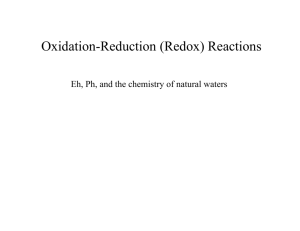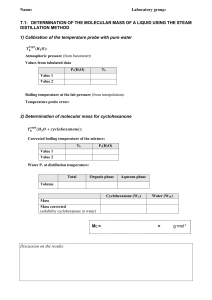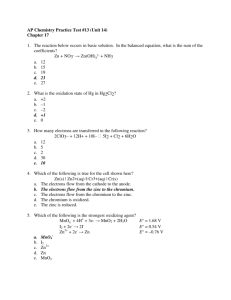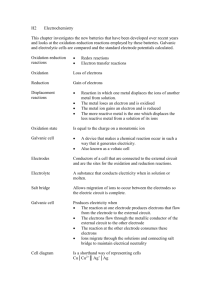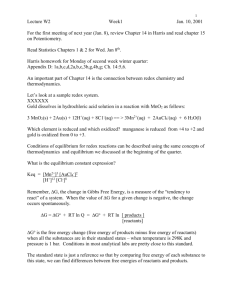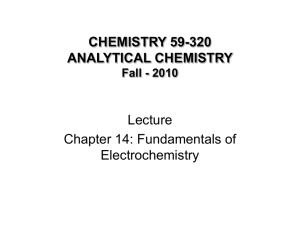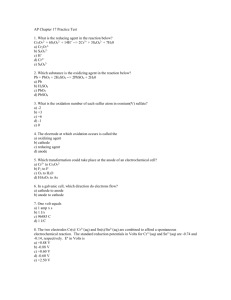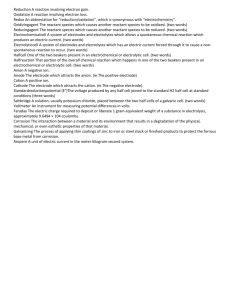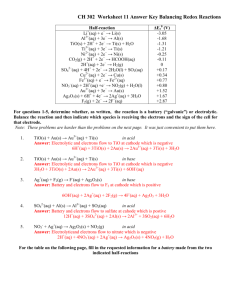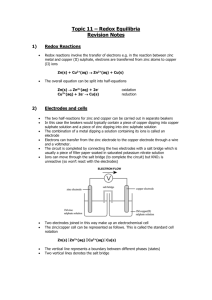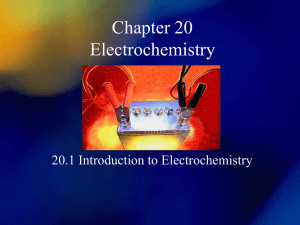Electrochemistry
advertisement
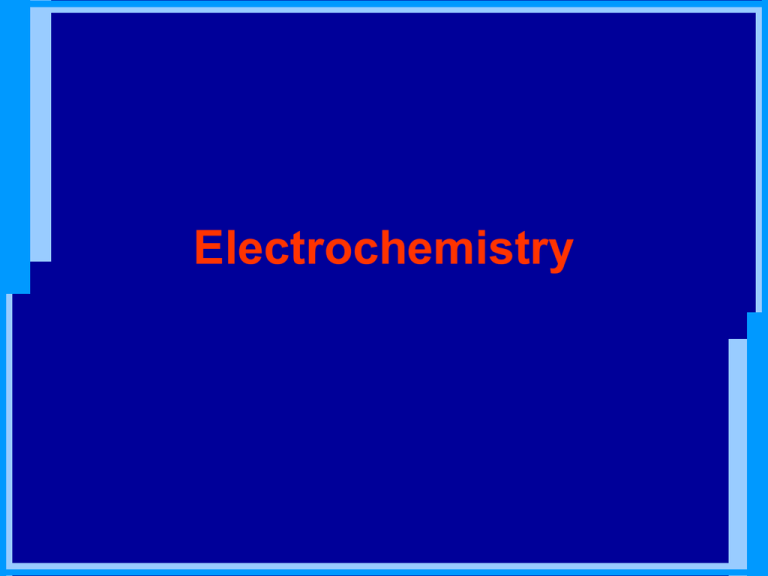
Electrochemistry It deals with reactions involving a transfer of electrons: 1. Oxidation-reduction phenomena 2. Voltaic or galvanic cell Chemical reactions can be used to produce eletrical energy: 3. Electrolytic cells Electrical energy can be used to bring about chemical transformations:electrolysis Oxidation and reduction Zn(s) + Cu2+(aq) Zn2+(aq) + Cu(s) Zn(s) Zn2+(aq) + 2eOxidation half-reaction Cu2+(aq) + 2e- Cu(s) Reduction half-reaction Galvanic /voltaic/ cells Electrode: e.g. a metal strip which can funcion as a cathode or an anode Half-cell: an electrode immersed in a solution containing the metal ions. Half of a voltaic cell in which an oxidation or a reduction occurs. Galvanic cell Electrode conventions Cathode Anode Ions attracted Cations Anions Direction of electron movement Into cell Out of cell Reduction Oxidation Positive Negative Negative Positive Half-reaction Sign Galvanic cell Electrolytic cell There is a difference in electrical potentials between the solution and the electrode Types of electrodes 1. Electrodes of the first kind: (metal electrodes) Zn, Cu, Fe, Au, Pt (indifferent) 2. Electrodes of the second kind: (calomel electrode) - metal: Hg - slightly soluble salt: Hg2 Cl2 precipitate - another soluble salt of its anion: KCl Hg2Cl2(s) Hg2(aq)2+ + 2Cl(aq)Ksp = [Hg22+ ][Cl-]2 /= 1.3 x 10-18/ 2Hg Hg22+ + 2e- 3. Gas electrodes: H2 /S.H.E./, Cl2 Membrane electrodes Glass electrode Ion-selective electrode: Na+, K+ It can be calculated by means of NERNST-equation E = E0 + RT ln c nF 0.059 E = E0 + n log c R = 8.314 J/K mol T = 298.15 K (25°C) F = 96 485 C/mol n = number of moles of electrons transferred Zn loses electrons, enters the solution. Cu gains electrons, deposits as metal. Electromotive force (E.M.F.) is the difference in potentials between the two half cells. E.M.F. = Ecat.(+) – Ean.(-) Cell diagrams Zn(s) I Zn (aq)2+ II Cu (aq)2+ I Cu(s) half-cell half-cell salt bridge At the left: At the right: - oxidation - reduction - anode - cathode - negative - positive Standard electrode potentials 0.059 E = E0 + n log c We can measure the potential differences only. Standard hydrogen electrode: S.H.E. E 0 = 0.0000 volt E=E0 if c = 1 mol Standard reduction potentials (at 25°C) Half-reaction Li+(aq) + e- Li(s) Ca2+(aq) + 2e- Ca(s) 2H+(aq) +2e- H2(g) E°(volts) - 3.05 - 2.76 0.00 Cu2+(aq) + 2e- Cu(s) Ag+(aq) + e- Ag(s) Cl2(g) + 2e- 2 Cl-(aq) F2(g) + 2e- 2F -(aq) + 0.34 + 0.80 + 1.36 + 2.87 Concentration cells Zn I 0.01M Zn2+ II 1M Zn2+ I Zn [Zn2+]1 0.059 2+ ] > [Zn 2+ ] E.M.F. = log ; [Zn 1 2 2 [Zn 2+]2 Measurement of pH Pt H2(g,1atm) I H+(xM) II H+(1M) I H2(q,1atm) Pt Ecell = 0.059 log [1] [H+] = 0.059 (-log [H+ ]) Ecell = 0.059 pH Redox cells Fe2+ Fe3+ + ereduced E = E0 + oxidized RT nF ln [ox] [red] [ox] 0.059 E = E0 + log n [red] T = 25°C Fe2+/Fe3+ S.H.E. Electrode potentials of some reduction oxidation systems Co2+ /Co3+ + 1.80V Pb2+ / Pb4+ + 1.80V MnO4- /Mn2+ + 1.52V Fe2+ /Fe3+ + 0.77V I2/2I - + 0.62V Sn2+ /Sn4+ + 0.15V Cytochrom a Fe3+ /Fe2+ 0.29V Cytochrom c Fe3+ /Fe2+ 0.22V Hemoglobin Fe3+ /Fe2+ 0.17V Cytochrom b Fe3+ /Fe2+ 0.07V Vitamin C ox/red 0.06V oxidizer reducer Electrolytic cell conduction Metallic Electrolytic Molten salt Aqueous soln. ClNa+ Electrolytic cell (Molten sodium chloride) Electrolysis: the use of electricity to bring about chemical change - Primary process: redox reaction, overvoltage - Secondary process: ….. Stoichiometry of electrolysis Faraday’s law m = kIt m = mass … k = electrochem. constant I = electric current in amperes t = time A = 1 C/s ampere sec. coulomb The quantity of charge equivalent to one mole of electrons is called the faraday (F) 1F = 96 485C 1F 1 g-equivalent
